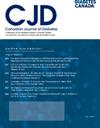Trends in Gestational Diabetes in Manitoba From 1981 to 2019: A Descriptive Study With Geospatial Mapping
IF 2.3
4区 医学
Q3 ENDOCRINOLOGY & METABOLISM
引用次数: 0
Abstract
Objective
This study aimed to describe trends in incidence of gestational diabetes in Manitoba and within subgroups that often experience health inequities.
Methods
We leveraged provincial administrative health data to describe trends in gestational diabetes incidence between 1981 and 2019, stratified by subpopulations based on age, urbanicity, and neighbourhood-level average household income. We calculated yearly incidence across subgroups and annual percent change in incidence to assess trends over time. Geospatial mapping was used to visualize changes by neighbourhood cluster.
Results
Gestational diabetes incidence increased from 1.3% to 8.6% between 1981 and 2019, with an upward inflection occurring around 2010. The annual percent change (APC) between 1981 and 2009, prior to the inflection point, was 1.9% (95% confidence interval [CI] 1.4% to 2.5%), and it was 11.7% (95% CI 8.9% to 14.7%) postinflection---from 2010 to 2019. After 2010, gestational diabetes incidence increased most among urban residents (APC 18.1%, 95% CI 13.9% to 22.5%), among those >35 years of age (APC 12.0%, 95% CI 8.4% to 15.7%), and among individuals in the highest socioeconomic status (SES) group (APC 14.8%, 95% CI 9.4% to 20.4%). Geospatial mapping showed that incidence increased more in neighbourhoods with the highest proportion of recent immigrants to Canada.
Conclusions
Incidence of gestational diabetes increased 6-fold in Manitoba over the past 20 years, particularly among those with high SES and higher age. Further research is required to clarify the role of screening practices in the trends observed in this work.
1981年至2019年马尼托巴省妊娠糖尿病趋势:一项地理空间测绘的描述性研究
背景:在经常经历健康不平等的亚群体中,描述妊娠期糖尿病发病率趋势的信息很少。方法:我们利用省级行政卫生数据来描述1981-2019年间妊娠糖尿病发病率的趋势,并根据年龄、城市化程度和社区平均家庭收入对亚人群进行分层。我们计算了亚组的年发病率和年发病率变化百分比,以评估随时间的趋势。利用地理空间映射对邻域聚类变化进行可视化。结果:妊娠期糖尿病发病率从1981年的1.3%上升到2019年的8.6%,2010年左右出现上升拐点。1981-2009年,拐点前的年百分比变化(APC)为1.9% (95% CI: 1.4-2.5%),拐点后2010-2019年的年百分比变化(APC)为11.7% (95% CI: 8.9-14.7%)。2010年以后,城镇居民妊娠期糖尿病发病率增加最多(APC= 18.1%;95%CI: 13.9-22.5),其中50 ~ 35岁(APC = 12.0%;95% CI: 8.4-15.7%),在社会地位最高的群体中(APC = 14.8%;95% ci: 9.4-20.4%)。地理空间测绘显示,在加拿大新移民比例最高的社区,发病率增加得更多。结论:在过去的20年里,曼尼托巴省妊娠期糖尿病的发病率增加了6倍,特别是在高SES和高年龄人群中。需要进一步的研究来阐明筛查实践在这里观察到的趋势中的作用。
本文章由计算机程序翻译,如有差异,请以英文原文为准。
求助全文
约1分钟内获得全文
求助全文
来源期刊

Canadian Journal of Diabetes
ENDOCRINOLOGY & METABOLISM-
CiteScore
4.80
自引率
4.00%
发文量
130
审稿时长
54 days
期刊介绍:
The Canadian Journal of Diabetes is Canada''s only diabetes-oriented, peer-reviewed, interdisciplinary journal for diabetes health-care professionals.
Published bimonthly, the Canadian Journal of Diabetes contains original articles; reviews; case reports; shorter articles such as Perspectives in Practice, Practical Diabetes and Innovations in Diabetes Care; Diabetes Dilemmas and Letters to the Editor.
 求助内容:
求助内容: 应助结果提醒方式:
应助结果提醒方式:


